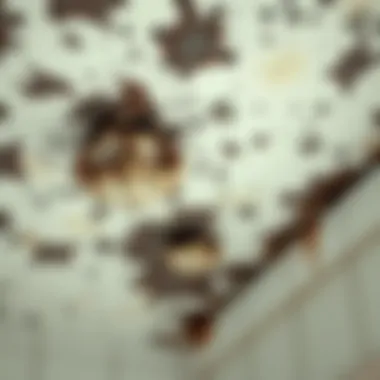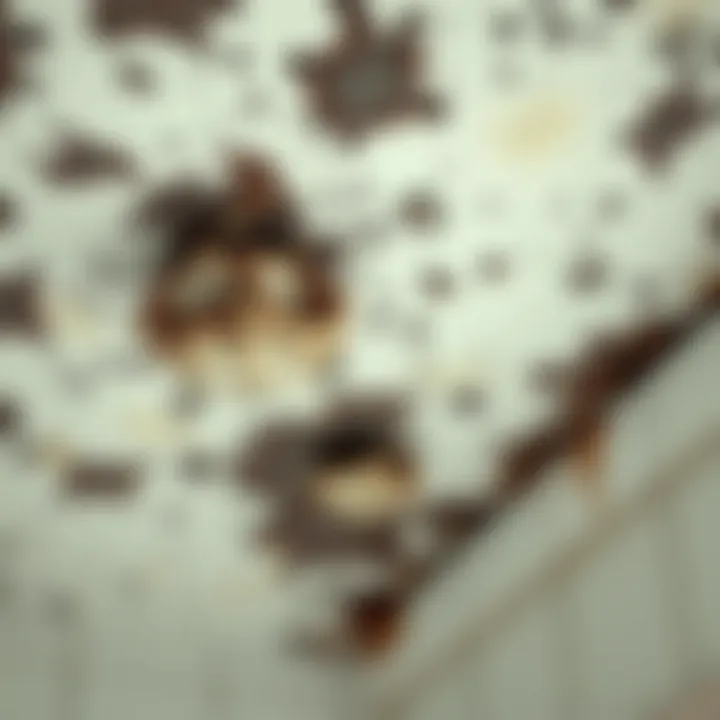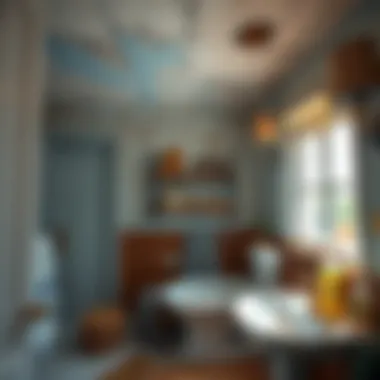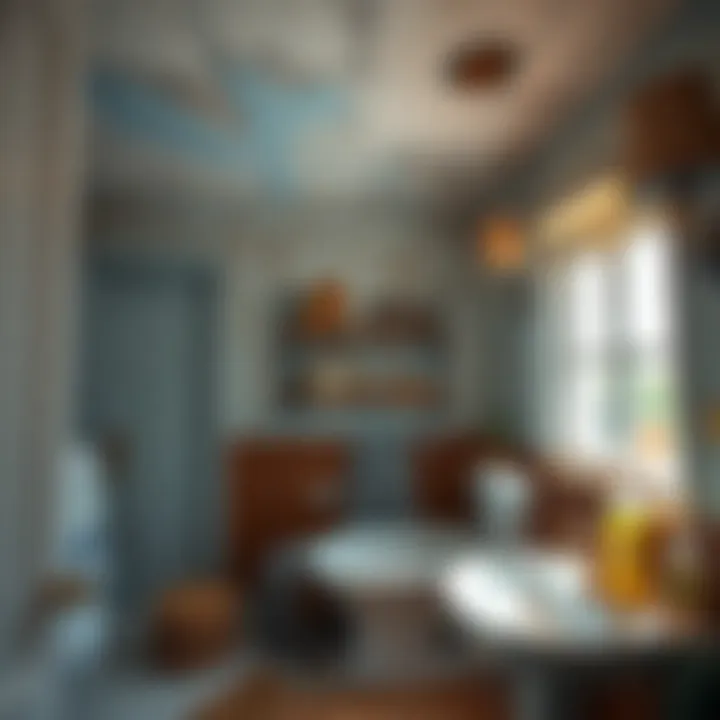Combatting Mold Growth in Bathroom Ceilings Effectively


Intro
Mold growth in bathroom ceilings is not just an aesthetic issue; it’s a concern that can significantly impact both health and home. The steam and humidity generated by showers creates an ideal breeding ground for mold spores. Before homeowners can tackle the problem, it's crucial to understand the many causes, the associated health risks, and effective remediation methods. This article aims to serve as a practical guide for those facing the nuisance of mold in their bathrooms.
Understanding mold allows us to make informed choices, whether it’s a matter of eliminating an existing colony or implementing preventive measures. From the complex nature of mold spores to how they thrive in our home environments, we will explore the paths towards ensuring a mold-free sanctuary.
Causes of Mold Growth
Mold spores are everywhere, lurking in the air and waiting for the right conditions to latch on and flourish. Key factors leading to mold growth in bathroom ceilings include:
- Excess Moisture: The primary catalyst. In bathrooms, moisture from hot water and insufficient ventilation leads to higher humidity levels.
- Poor Ventilation: Without proper airflow, steam accumulates. This can result in a damp environment conducive to mold growth.
- Leaky Pipes: Water leaks, whether minor drips or significant bursts, can create wet spots that attract mold.
- Surface Material: Certain materials, like drywall or wood, can absorb moisture, making them more susceptible to mold.
Health Risks Associated with Mold
Mold isn’t just an eyesore; exposure can lead to a range of health problems, especially for sensitive individuals. Potential health risks include:
- Allergic Reactions: Symptoms such as sneezing, runny nose, and itchy eyes can arise from mold exposure.
- Respiratory Issues: Mold particles can lead to coughing, wheezing, and even more severe respiratory conditions for asthmatic or compromised individuals.
- Skin Irritation: Simply touching surfaces with mold can result in rashes or skin irritations.
"Mold can be more than just a household nuisance; it can represent a serious health threat, especially for sensitive populations."
Effective Remediation Methods
When dealing with mold on bathroom ceilings, it’s essential to act quickly and efficiently. Here are a few effective methods homeowners can use:
- Identify the Source: Examine pipes and structures to find and fix any leaks or moisture problems.
- Improve Ventilation: Install or upgrade exhaust fans. This will help reduce humidity. Opening windows while showering can also assist.
- Mold Removal Solutions: For small areas, a mixture of water and vinegar can be quite effective. For larger infestations, mold-specific cleaners should be used.
- Replacement of Materials: If siding or drywall is extensively damaged, it may be necessary to remove and replace affected areas.
- Professional Help: For severe cases, bring in a professional mold remediation service.
Prevention Tips for a Mold-Free Bathroom
Prevention is the best remedy for mold growth. Consider the following strategies:
- Regular Cleaning: Keep surfaces clean and dry. Regularly check for signs of mold and act promptly if spotted.
- Use Mold-Resistant Products: Paints and drywall designed to resist mold can offer additional protection.
- Monitor Humidity Levels: Using a hygrometer can help keep humidity levels in check, ideally between 30-50%.
Finale
Navigating mold growth in bathroom ceilings requires a thorough understanding of its causes and associated risks. By implementing strategic approaches to address and prevent mold, homeowners can create a healthier living environment. Remember, maintaining adequate ventilation and keeping moisture at bay are fundamental to enjoying a mold-free bathroom for years to come.
For additional information on mold remediation and health impacts, you may find the following resources helpful:
Centers for Disease Control and Prevention
Environmental Protection Agency
Wikipedia on Mold
Reddit Discussions
Facebook Home Improvement Groups
Educating oneself regarding mold can help maintain a safe and clean atmosphere at home.
Understanding Mold Growth
Mold growth in bathroom ceilings is a serious concern for homeowners and housewives alike. Understanding this topic is crucial for several reasons. First and foremost, it enables individuals to identify and tackle mold issues before they escalate. Knowledge of how mold spreads transforms an abstract worry into actionable steps. Additionally, comprehending the biology, ideal conditions, and types of mold found in bathrooms ignites awareness. Such awareness is essential since ignorance can lead to health risks for family members.
Biology of Mold
Mold is a type of fungus, and although it can be quite the nuisance, it plays a vital role in our ecosystem by decomposing dead organic matter. Its life cycle follows a simple pattern: spores are released, they settle on a suitable surface, and, given ideal conditions, they grow. Mold is often invisible but can flourish in damp areas like bathrooms. The growth process may seem slow, yet it can accelerate quickly, especially in favorable environments. In a nutshell, mold reproduces through tiny spores that travel in the air, landing on suitable surfaces and thriving in moisture-rich environments.
Ideal Conditions for Mold Proliferation
For mold to proliferate, it needs a combination of warmth, moisture, and a food source. Bathrooms, with their regular exposure to water and steam, create the perfect breeding ground. Here are some conditions that favor mold growth:
- High Humidity: Humidity levels above 60% are prime targets for mold species.
- Poor Ventilation: Stagnant air fails to remove moisture effectively, shooting up the chances of mold.
- Organic Materials: Mold fees on materials like drywall, wood, and even soap scum.
Research shows that even low levels of moisture can trigger mold development, making ongoing vigilance necessary.
Types of Mold Found in Bathrooms
Several types of mold may inhabit bathroom ceilings, some more dangerous than others. Here’s an overview of common offenders:
- Aspergillus: Often found in bathrooms, this mold can trigger allergic reactions in sensitive individuals.
- Cladosporium: Another common mold, it thrives in damp spaces and can irritate the respiratory system.
- Stachybotrys (Black Mold): While it is less common, its presence is alarming due to its potential to cause more severe health problems.
- Penicillium: Frequently found in homes, it can cause allergic responses.
Understanding these types of mold helps homeowners pinpoint their level of risk. Knowledge is power, and in this case, it can lead to safer living conditions.
Identifying Mold in Bathroom Ceilings
Identifying mold in bathroom ceilings is crucial for homeowners who want to ensure a healthy living space. Mold often hides in plain sight, making it challenging to spot until it has become a real problem. By understanding how to recognize mold early, one can save both health and home from significant damage. Not only does timely identification prevent further spread, but it can also minimize health risks posed by mold exposure.


Visual Signs to Look For
When inspecting your bathroom ceiling, keep an eye out for various visual cues that could indicate mold's unwelcome presence. Here are some common signs:
- Dark Spots or Stains: These can range in color from black to greenish or brownish tones. If you notice any unusual discoloration, it's worth investigating.
- Blisters or Peeling Paint: If the paint on your bathroom ceiling begins to bubble or peel, moisture is likely trapped beneath the surface, facilitating mold growth.
- Texture Changes: Mold may change the texture of surfaces. If your ceiling texture appears different, it might indicate a mold problem.
- Visible Growth: In some cases, mold might be visibly growing, appearing as fuzzy patches or irregular shapes starting to develop.
This visual inspection doesn't have to be tedious. Making it a regular part of your cleaning routine can help stay ahead of issues.
Unpleasant Odors as Indicators
Another telltale sign of mold in bathroom ceilings is the presence of musty odors. If the bathroom starts to smell damp or earthy, it’s more than just a scent issue; it suggests potential mold presence. Mold releases volatile organic compounds, which lead to those unpleasant smells. Here’s what to note:
- Lingering Musty Smell: If you're consistently greeted by an unpleasant odor, it could indicate hidden mold colonies.
- Odor Changes After Showers: If the smell intensifies after bathing or showering, be aware that steam can encourage mold growth, making it more prominent.
Getting to the root of these odors is essential, as they not only signify mold but can also lead to health issues for you and your family.
Health Symptoms Associated with Mold Exposure
Being aware of health symptoms that arise from mold exposure is crucial, especially in a space like the bathroom where people spend significant time. Common symptoms include:
- Respiratory Issues: Coughing, wheezing, or difficulty breathing can be triggered by mold spores affecting the air quality and potentially leading to asthma attacks.
- Allergic Reactions: Symptoms like sneezing, runny nose, or itchy eyes can all stem from mold allergies, which some individuals are predisposed to.
- Skin Irritations: Skin rashes or other irritations might occur upon contact with mold or mold spores.
- Fatigue and Headaches: Prolonged exposure to a mold-infested environment can lead to fatigue, headaches, and other general malaise.
If you or anyone in your home begins experiencing these symptoms, it's prudent to take action. Identifying mold is the first step in ensuring a healthy environment and addressing any underlying moisture issues in the bathroom.
Remember: Early identification and intervention are key; don’t wait until the mold becomes a bigger issue to act.
Health Implications of Mold Exposure
Mold might be a seemingly minor issue, but the consequences of ignoring it can be significant, particularly when it comes to our health. Understanding the health implications of mold exposure is critical for homeowners who want to keep their living spaces safe. Mold releases spores and other particles that can cause a variety of health concerns.
When mold infests a bathroom ceiling, it can easily become a part of the air we breathe. Many people overlook these potential hazards, thinking that a little mold is just a cosmetic problem. However, the reality is that mold can trigger severe allergic reactions and respiratory issues, along with posing long-term health risks. Thus, it's crucial to take this topic seriously and remain vigilant.
Allergic Reactions and Respiratory Issues
Exposure to mold can lead to immediate allergic reactions in sensitive individuals. Symptoms often manifest as sneezing, runny nose, itchy eyes, and skin irritations. Living or spending time in an environment contaminated with mold puts people at risk for developing respiratory issues, especially if they already have conditions like asthma or chronic bronchitis.
- Common Allergic Reactions:
- Sneezing or nasal congestion
- Itchy or watery eyes
- Skin rashes or hives
These reactions can vary from person to person. Children and the elderly are particularly vulnerable, as their immune systems may not respond as effectively. For instance, someone might find themselves constantly reaching for tissues, especially after a shower when moisture in the air helps mold thrive. The impact on quality of life can be detrimental, affecting productivity at work and overall well-being.
Additionally, individuals with asthma can encounter exacerbated symptoms, making it harder to breathe. In severe cases, mold exposure might even trigger asthma attacks, leading to panic and distress. It's not just a nuisance; it can be a serious health concern that demands immediate action.
“Ignoring mold can transform from a minor inconvenience to a significant health hazard in the blink of an eye.”
Long-term Health Risks
Mold is not just a transient adversary. Prolonged exposure can result in long-term health issues, which can become particularly alarming for those who are exposed over extended periods. Conditions like chronic pulmonary issues and even psychological effects can stem from consistent inhalation of mold spores.
- Potential Long-term Effects:
- Chronic respiratory diseases such as bronchitis
- Increased frequency of asthma attacks
- Possible development of hypersensitivity pneumonitis, a condition that affects lung function
- Mental health adverse effects, including anxiety and depression related to persistent fatigue or discomfort from symptoms
Some studies suggest that exposure to mold may even trigger autoimmune responses, whereby the body begins to attack healthy cells, mistaking them for invaders. This could lead to complications that extend far beyond the bathroom walls.
Mold can infiltrate one's daily life, leading to missed work days and a decrease in overall life satisfaction. Households that experience ongoing mold issues might find that their insurance premiums increase due to elevated health risks, adding yet another layer of concern.
Remediation Techniques for Bathroom Mold
When it comes to managing mold in bathrooms, particularly on ceilings, the adoption of effective remediation techniques is crucial. Mold isn’t just an eyesore; it’s a potential health risk that can trigger allergies and respiratory problems. Addressing it promptly ensures a healthier living environment. The techniques discussed here are not just about cleaning; they are about understanding the comprehensive steps to eradicate the issue and prevent its recurrence.
Safe Removal Methods
Removing mold safely requires a methodical approach. The first step is to equip yourself with appropriate personal protective equipment (PPE), such as gloves, goggles, and, often, a mask. This step cannot be overstated—mold spores are often airborne and can easily enter your respiratory system.
Here are effective removal techniques you can utilize:
- Vinegar Solution: White vinegar, as it is mild and effective, can be applied directly to moldy areas. Simply spray it on, let it sit for at least an hour, then wipe away the mold with a damp cloth.
- Baking Soda Mixture: Combine baking soda with water to form a paste and apply it on the affected area. This method helps to cover odors and also won’t harm the surfaces.
- Hydrogen Peroxide: A solution of 3% hydrogen peroxide can be used similarly, allowing it to sit for about 10 minutes before scrubbing the area clean. It’s particularly effective against tough mold stains.


Important Note: Always ensure proper ventilation when using these substances. Opening windows and utilizing exhaust fans during cleaning is essential to ensure mold spores do not linger in the air.
The approach may vary based on how widespread or severe the mold contamination is. Larger areas or more serious infestations may warrant different treatments or combinations of methods.
When to Call a Professional
While many homeowners can manage small mold problems themselves, there are certain situations when it’s best to call in the experts. Recognizing the right time to seek professional help can save time, money, and potential health risks.
Consider enlisting a professional mold remediation service in the following cases:
- Severe Infestation: If you are dealing with extensive mold growth, especially beyond 10 square feet, a professional's expertise will ensure proper investigation and treatment.
- Structural Damage: If the mold has compromised the integrity of your bathroom ceiling or walls, such as rot or crumbling materials, professionals can assess and repair damage.
- Persistent Recurrence: If you’ve treated the mold multiple times but it keeps coming back, it may indicate underlying issues, like moisture retention or ventilation deficits that professionals are equipped to address.
- Health Concerns: If you or anyone in your household is experiencing health issues related to mold exposure, it’s prudent to seek professional assistance to ensure safe and thorough remediation.
In the larger scheme of things, knowing when to tackle the problem yourself and when to seek help is a critical element of successful mold management that ensures both safety and long-term cleanliness in your home.
Preventative Measures Against Mold
When it comes to mold in your bathroom, an ounce of prevention is indeed worth a pound of cure. Implementing regular preventative measures is crucial not just for keeping mold at bay, but for ensuring that your home remains a healthy environment. Addressing mold growth before it becomes a problem not only saves you from costly remediation efforts but also nurtures the well-being of everyone living under your roof.
Improving Bathroom Ventilation
Good ventilation does wonders in combating moisture buildup, which mold so fondly feeds on. Keeping air flowing freely can mean the difference between a moldy ceiling and a spotless sanctuary.
You can start by installing an exhaust fan, which is particularly essential for bathrooms that don’t have windows. Make sure that the fan is adequately sized for your space, and always run it during showers and for at least 30 minutes afterward.
- Consider the following tips:
- Regularly check your exhaust fan to ensure it works properly.
- Open windows whenever possible to bring in fresh air.
- If there are any stagnant air pockets, think about supplementing with a dehumidifier.
Taking control of humidity through adequate ventilation can significantly hamper mold growth and help maintain a pleasant atmosphere in your bathroom.
Regular Maintenance and Cleaning Routines
A little elbow grease goes a long way in mold prevention. Developing a cleaning schedule can keep dirt, grime, and mold spores at bay. Focus on areas that typically get overlooked, such as behind the toilet, inside cabinets, and above shower doors, where moisture can hide away.
- Key points to consider for your routine:
- Use warm soapy water to scrub surfaces, especially those that are porous like grout.
- Make use of natural anti-fungal agents such as vinegar and baking soda—they pack a punishing punch against mold without the harsh chemicals.
- Regularly wash bath mats and shower curtains, as these can trap moisture and become real breeding grounds for mold.
Incorporating these cleaning habits into your regular routine not only combats mold but also enhances the overall hygiene of your bathroom space.
Using Mold-Resistant Materials
When remodeling or upgrading your bathroom, choosing materials that resist mold can save you headaches down the road. Materials like mold-resistant drywall and paints that contain mildewcides provide an additional layer of defense against mold growth.
- Consider the following mold-resistant options:
- Mold-resistant drywall: This type has a special coating that helps prevent moisture absorption.
- Mildew-resistant paint: An effective option that limits mold growth on painted surfaces.
- Water-resistant flooring: Think vinyl that can withstand the humidity and is easy to clean.
Investing in these materials not only bolsters your home’s resilience against mold but also increases its value.
"A proactive approach, combining ventilation, cleanliness, and the right materials, creates a powerful shield against mold growth in any bathroom."
By embracing these preventative measures, you'll not only keep your ceilings mold-free, but you'll also contribute to a healthier home environment overall.
The Role of Humidity Control
Controlling humidity is a crucial element in the fight against mold growth in bathroom ceilings. When humidity levels rise above a certain threshold, a breeding ground for mold is created. The relationship between humidity and mold is not just coincidental; it's deeply intertwined. If homeowners can master this relationship, they can significantly reduce the risk of mold-related issues in their bathrooms.
Maintaining optimal humidity levels not only keeps mold at bay but promotes a healthier living environment. High humidity can lead to persistent dampness, making it inviting for mold spores to settle. On the flip side, using dehumidifiers and ensuring proper ventilation breaks this cycle of moisture accumulation.
Understanding Humidity Levels
Humidity levels are expressed as a percentage, indicating how much moisture is in the air compared to the maximum amount the air can hold at that temperature. Typically, a relative humidity of 30% to 50% is considered ideal, especially in bathrooms. When the numbers creep closer to 60% or higher, mold gains an upper hand, taking advantage of that humidity for growth.
To visualize this, think of it as a sponge. At 50% humidity, the air is like a half-soaked sponge; still manageable. But when it hits 70%, that sponge is drenched, creating puddles—just like mold does in your bathroom. Homeowners should aim to keep that sponge damp but not soaked.
Key Considerations for Humidity Levels:
- Seasonal Changes: During warmer months, humidity often rises. Homeowners may need to adjust their strategies to maintain a balanced environment.
- Bathing Habits: Long, hot showers can spike humidity levels. It's essential to implement measures that mitigate these spikes effectively.
- Cooking Activities: Surprisingly, cooking can also add to bathroom humidity levels if connecting ducts or ventilation systems aren't well designed.


Tools for Measuring Humidity
Being aware of humidity levels is one thing, but measuring them accurately is another. Various tools can assist homeowners in keeping track of moisture in the air and making informed decisions on how to proceed.
- Hygrometers: These devices measure the humidity in the air and are often affordable and easy to use. They can guide you when taking actions like running a dehumidifier.
- Smart Thermostats: Some modern thermostats come with built-in humidity monitoring, allowing for an integrated solution when managing home comfort.
- Indoor Weather Stations: These systems measure humidity, temperature, and often air pressure, giving a comprehensive view of your indoor climate.
"Monitoring humidity is not just about comfort; it’s about safeguarding your health and home against mold growth."
Utilizing these tools can bring peace of mind to homeowners. Regular checks can alert homeowners to rising humidity levels before they become a serious concern.
Choosing the Right Cleaning Products
Selecting appropriate cleaning products is crucial in the battle against mold growth on bathroom ceilings. Not all products are created equal, and making informed choices can significantly impact effectiveness and safety. When looking to tackle mold, homeowners must consider not just what will work but how it affects both health and the environment.
Evaluating Product Effectiveness
When assessing the effectiveness of various cleaning products, it’s important to consider several factors. Here are a few key points to keep in mind:
- Active Ingredients: Look for products that specifically mention mold-fighting properties, such as hydrogen peroxide or quaternary ammonium compounds. These ingredients are known for their ability to kill mold spores effectively.
- Residue After Use: A cleaner that leaves behind residues can inadvertently promote further growth. Ensure the product rinses away easily and completely.
- User Reviews: Real feedback from other homeowners can be invaluable. Look for testimonials or reviews discussing user experiences with mold removal.
- Testing Area: Before fully committing to a product, test it in a small, inconspicuous area. This not only checks effectiveness but also shows if there’s any damage or discoloration to the paint or material on the ceiling.
The right cleaner should not only lift stubborn stains but should ideally prevent future mold from taking hold. Remember to embrace a holistic approach; sometimes the best results come from combining different cleaning strategies.
Safety Considerations in Product Selection
When choosing mold cleaning products, safety is paramount. Addressing mold growth means exposing oneself and family to certain chemicals, so here’s what to watch out for:
- Toxicity: Many conventional cleaners contain harsh chemicals that can cause respiratory issues, skin irritations, or other health problems. Always read labels carefully and opt for products marked as non-toxic and eco-friendly whenever possible.
- Proper Ventilation: Whatever product you choose, make sure to use it in a well-ventilated area to minimize inhalation of fumes. Cracking a window open or using a fan can help dissipate irritating odors.
- Protective Gear: Wearing gloves and masks is highly advisable when applying mold cleaning products, even if they are labeled as safe. It can prevent skin contact and reduce inhalation of any volatile organic compounds (VOCs).
- Follow Instructions: Each product has specific guidelines for use. Adhering to these can not only ensure effectiveness but also reduce health risks. Don’t skimp on this; even a small oversight can lead to unintended consequences.
Choosing the right cleaning products goes beyond mere efficacy. It combines common sense with a bit of knowledge and attention to safety protocols to create a comprehensive approach to mold management. Regular vigilance in product selection ensures that your bathroom remains a healthy haven rather than a breeding ground for mold.
Impact of Plumbing Issues on Mold Growth
Dealing with mold in the bathroom is more than just a skincare issue; it’s often tied directly to underlying plumbing problems. Mold thrives on moisture, and when plumbing is faulty, it provides the perfect breeding ground. Ignoring this connection can lead not only to a mold infestation but also to significant property damage and health risks. Homeowners must recognize the impact of plumbing issues on mold growth so they can tackle the problem head-on.
Identifying Leaks and Moisture Sources
Finding leaks may feel like looking for a needle in a haystack, but it’s crucial in preventing mold from taking hold. Common culprits include:
- Pipe Leaks: Aging pipes can develop small cracks or corrosion, leaking water into your walls and ceilings. If you notice any discoloration or peeling in the paint, it could result from a hidden leak.
- Sink and Shower Fixtures: Check under sinks for signs of water. Dripping faucets or poorly sealed showerheads often lead to water pooling in places it should not be.
- Toilet Issues: A leaking toilet base can also be a source of excess moisture. Inspect the floor around the toilet for dampness to catch any problems early on.
It’s important to be proactive about identifying these issues. Regularly inspect all visible plumbing and look beyond the surface for signs of water damage. A simple check-up can save a lot of trouble down the line.
Importance of Prompt Repairs
Mold doesn’t waste time when it finds a feast of dampness. As soon as you uncover a leak, addressing it quickly is vital. The longer you let it fester, the bigger the problem can become.
- Cost-Effectiveness: Delaying repairs can lead to more severe damage, requiring costly remediation efforts later. Fixing a leaky pipe now can save hundreds or thousands in mold removal services in the future.
- Health Considerations: Mold exposure can trigger respiratory issues, allergic reactions, and other health complications, especially in sensitive groups like children and the elderly. Promptly repairing plumbing leaks helps in controlling potential health risks.
- Preservation of Property Value: A mold issue can deter potential buyers if you ever decide to sell your home. Keeping your plumbing in top shape ensures your property maintains its value over time.
"An ounce of prevention is worth a pound of cure."
By fixing the plumbing issues promptly, you ensure a healthier living environment and maintain the integrity of your home. Regular maintenance checks and immediate action on leaks not only keep mold at bay but also contribute to the overall longevity of your house.
Final Thoughts on Mold Management
Mold management in bathroom ceilings isn’t just a task; it's a commitment to maintaining a safe and healthy home environment. Understanding mold's behaviors and the conditions that foster its growth can greatly empower homeowners. In this final section, we will highlight the significance of mold management, focusing on actionable strategies that can be integrated into daily routines, promoting a lifestyle free from health hazards associated with mold proliferation.
Creating a Comprehensive Action Plan
Establishing a solid action plan is paramount in tackling mold issues head-on. Here are several key components to consider:
- Conduct Routine Inspections: Encourage regular checks of your bathroom ceilings, keeping an eye out for changes like discoloration or dampness. Making this a habit can help detect mold before it becomes a bigger problem.
- Document Findings: Keeping a record of inspections helps in tracking the mold situation. Noting occurrences and any treatment efforts can guide future actions and remind you of the patterns to watch for.
- Outline Remediation Steps: Be clear about what actions to take if mold is found. This might involve safe removal methods, the types of products to use, and whether to call a professional. Know your limits and plan accordingly.
- Set Maintenance Routines: Timing is everything. Schedule cleaning days and maintenance tasks. Setting a calendar reminder can keep you on track to perform regular upkeep, reducing the chance for mold to set in.
Building this action plan not only ensures that you are prepared to tackle mold issues but also instills a proactive mindset.
Long-term Strategies for a Mold-Free Home
For a genuine shift towards an ongoing mold-free existence in your home, consider these long-term strategies:
- Invest in Dehumidifiers: Maintaining low humidity levels is key to mold prevention. A dehumidifier can help regulate moisture easily, especially in the bathroom.
- Opt for Mold-Resistant Materials: When remodeling or updating your bathroom, using mold-resistant paint or drywall can save a lot of trouble down the line.
- Mind the Air Flow: Proper ventilation is non-negotiable. Regularly use exhaust fans, and ensure window treatments do not block natural airflow.
- Educate the Household: Sharing information about mold and its risks among family members ensures everyone is on the same page. Encouragement from a collective effort often leads to better results.
By implementing these strategies, homeowners can create an environment that’s not only safe but resilient against future mold growth.
"An ounce of prevention is worth a pound of cure." - Benjamin Franklin
Ultimately, addressing mold in bathroom ceilings transcends mere removal; it represents a lifestyle shift towards vigilance and responsible home care. Take the insights from this article to heart, and let them guide you towards a healthier, mold-free living space.















